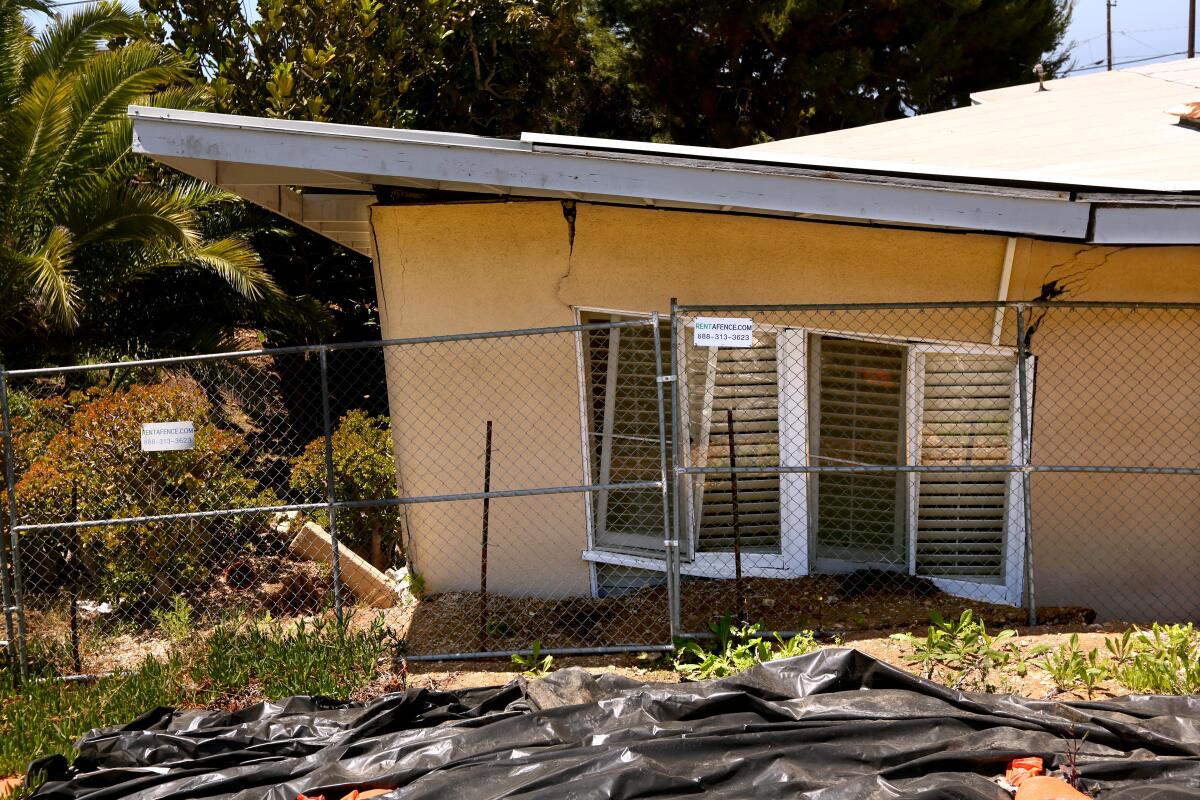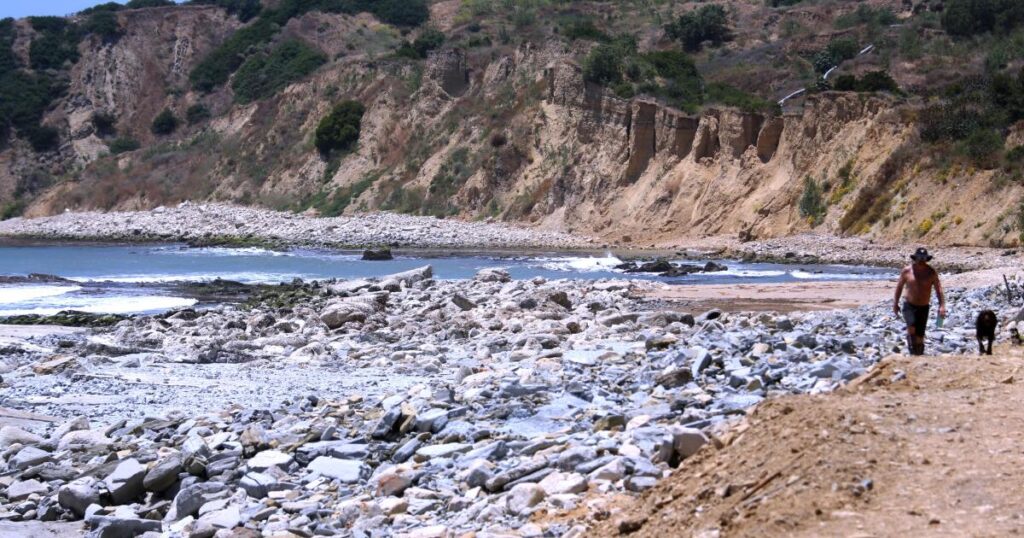Rancho Palos Verdes has a brand new shoreline.
Rapidly expanding and accelerating landslides on the southeastern tip of the Palos Verdes Peninsula continue to wreak havoc on homes, roads and utilities in the area, even forcing the iconic Wayfarers Church to at least temporarily abandon its location.
But it also led to a new, unforeseen change at the water’s edge: the seafloor was pushed upward, effectively creating new beaches.
“That beach is brand new,” Denny Jaconi said, pointing to the rocky shoreline that he said didn’t exist just a few months ago. “Three or four of us have been surfing here our whole lives and we were just blown away because it was unreal.”
The waters that once met the waves during Iaconi’s childhood (and even just a few months ago) have now been replaced by a vast rocky shore that has transformed as the force of the landslide pushes bentonite clay up from beneath the sand.

“That beach is brand new,” Denny Jaconi said, pointing to the rocky shoreline that he said didn’t exist just a few months ago.
(Genaro Molina/Los Angeles Times)
“Things change every week,” he said, as new reefs appear regularly.
Jaconi, 45, is a lifelong resident of Portuguese Bend Beach Club, a small gated community off Palos Verdes Drive South that offers the most Direct access to the growing beach. The nearby large white sand beach has also recently been raised into a hillside. Visitors coming from Seawall Road must climb onto the now-packed sand to see the water.
But the changes brought about by accelerating land movement don’t end there, Iaconi said.
Nearly every home in their neighborhood has sustained significant damage, with cracks in walls, stuck doors, collapsed decks and shifting foundations worsening every day. Many parts of the main road have been reduced to gravel due to excessive cracks in the road surface. The community’s waterfront tennis courts were recently demolished and their corrugated floors no longer allow for play.
For most people living there, it was their first time seeing the devastation caused by the landslide, which consists of at least five separate slides, including the largest and most active Portuguese Bend slide. Land movement has plagued the region since a resurgence of some ancient landslides in the 1950s, but officials say the latest movement – the result of a succession of wet winters – is unlike anything on record.
“Unfortunately, things are moving faster than at any time in history,” Mike Phipps, the city’s geologist, said at Tuesday night’s City Council meeting. In his latest report, he noted that landslides continue to affect new areas, with some locations moving as much as 13 inches per week. For decades, most areas have been moving nearly a few inches a year — if that.
This new, rapid movement transformed the coastline.
“The Portuguese Beach Club area continues to experience significant deformation along the seawall with approximately 4 to 5 feet of uplift/bulge along the entire beach,” Phipps wrote in the latest report. “This deformation appears to continue offshore… A large presence of land based on the southeastern toe of the surf zone and nearshore zone [Portuguese Bend landslide]”.
He said that after part of the ocean floor moved about 10 feet vertically, the new shoreline was about 250 feet farther out to sea, “which is a manifestation of the larger, deeper, longer movement of the Portuguese Bay landslide.”
Although the results are new to the region, geologist El Hachemi Bouali said the movement is “actually normal for landslides.”
“Typically, landslide complexes lose material at the top and gain material at the bottom,” said Buali, an assistant professor of geosciences at Nevada State University who has long studied the Portugal Bend landslide complex. “If enough material accumulates at the bottom and is not removed by erosion, a bulge or bulge may occur as the material accumulates and deforms upward.”
Iaconi said it was unreal to watch these geological forces play out in real time in an area he thought he knew so well.
“Showing our kids this new coastline … it’s a completely different place,” he said.
But the coastal changes were also a bright spot for Iaconi as the disaster mounted, breaking numerous water and natural gas lines, red-tagging at least two homes in the area and forcing his family to make extensive repairs in an attempt to Save and rebuild homes.

An ongoing landslide in the Portuguese Bend neighborhood of Palos Verdes has caused considerable damage to some homes.
(Genaro Molina/Los Angeles Times)
With waves now crashing against rocks instead of dusty hillsides, the new beach has made the water clearer, creating better habitats for marine life and new swimming spots, he said.
“This is like our comfort in this disaster,” Iaconi said. “It’s like, ‘Oh, we have a private beach there and a couple of new surf spots.'”
He wonders if officials will find a way to slow the devastating land movement. But he remains hopeful for his family’s future here, dreaming of raising his 5-month-old son on the same — well, different — coast where he grew up.
“We have new tide pools here for the kids,” he said. “There are new kelp beds out there and a lot of pelicans have just left. … Now we have about 50 feet of shoreline between the ocean and the landslide.

